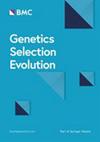Genomic analyses of Asiatic Mouflon in Iran provide insights into the domestication and evolution of sheep
IF 3.1
1区 农林科学
Q1 AGRICULTURE, DAIRY & ANIMAL SCIENCE
引用次数: 0
Abstract
Asiatic mouflon (Ovis gmelini) consists of several subspecies mainly distributed in Armenia, southern Azerbaijan, Cyprus, northern, southern, and western regions of Iran, and eastern and central regions of Turkey nowadays. Genome analyses of Asiatic mouflon in Iran revealed that they could have diverged from the direct ancestor of domestic sheep, and showed genetic introgression into domestic sheep after domestication. However, the impact of the Asiatic mouflon subspecies in Iran on sheep domestication remains unclear. Here, we conducted a comprehensive population genomics analysis of Asiatic mouflon in Iran with 788 whole-genome sequences (including 40 from Asiatic mouflon), 1104 whole mitogenomes (105 from Asiatic mouflon), and 239 Y chromosomes (21 from Asiatic mouflon). Whole-genome sequence analyses revealed two subpopulations of Asiatic mouflon in Iran: O. gmelini_2 limited on Kaboodan Island in Urmia Lake National Park and O. gmelini_1 over a wide geographic area. Phylogenetic analyses of Asiatic mouflon in Iran based on uniparental variants revealed a monophyletic lineage with the mitochondrial haplogroups C/E, and clustered into a monophyletic with Y-chromosomal lineage HY2 of sheep. Additionally, introgression tests detected significant signals of genetic introgression from O. gmelini_2 to four sheep populations (e.g., Garut, Bangladeshi, Nellore, and Sumatra) in South and Southeast Asia. In the four sheep populations, selective tests and introgression signals revealed that the wild introgression could have contributed to their body size, fat metabolism and local adaptation to the hot and humid environments in the Indian Peninsula. Our results clarified subpopulation structure of Asiatic mouflon in Iran, identifying two distinct groups: O. gmelini_1 and O. gmelini_2. Additionally, we suggest a potential genetic contribution to domestic sheep by introgression, with maternal haplogroup C and paternal lineage HY2 likely originating from the Asiatic mouflon populations in Iran. Our findings offer new insights into domestication of sheep and subsequent introgressions events from wild relatives to domestic populations.对伊朗亚洲穆弗伦羊的基因组分析提供了对羊的驯化和进化的见解
亚洲摩夫龙(Ovis gmelini)由几个亚种组成,现今主要分布于亚美尼亚、阿塞拜疆南部、塞浦路斯、伊朗北部、南部和西部地区以及土耳其东部和中部地区。对伊朗亚洲摩弗龙的基因组分析表明,它们可能是从家羊的直系祖先分化出来的,并且在驯化后表现出遗传渗入到家羊的现象。然而,伊朗的亚洲摩弗伦亚种对绵羊驯化的影响尚不清楚。在这里,我们对伊朗的亚洲摩弗龙进行了全面的群体基因组学分析,包括788个全基因组序列(其中40个来自亚洲摩弗龙),1104个全有丝分裂基因组(105个来自亚洲摩弗龙)和239个Y染色体(21个来自亚洲摩弗龙)。全基因组序列分析显示,伊朗有2个亚种:O. gmelini_2分布于乌尔米亚湖国家公园的Kaboodan岛上,O. gmelini_1分布在广泛的地理区域。基于单亲本变异的伊朗亚洲莫弗龙的系统发育分析显示其具有线粒体单倍群C/E的单系谱系,并聚集为具有绵羊y染色体谱系HY2的单系谱系。此外,在南亚和东南亚的4个绵羊种群(如Garut、bangladesh、Nellore和Sumatra)中,通过基因渗入测试发现了O. gmelini_2基因渗入的显著信号。在这4个绵羊种群中,选择性测试和基因渗入信号显示,野生基因渗入可能有助于它们的体型、脂肪代谢和对印度半岛湿热环境的局部适应。研究结果明确了伊朗亚洲摩伦的亚种群结构,确定了两个不同的类群:O. gmelini_1和O. gmelini_2。此外,我们还认为,母系单倍群C和父系系HY2可能来自伊朗的亚洲mouflon种群,可能通过遗传渗入对家养绵羊有潜在的遗传贡献。我们的发现为羊的驯化以及随后从野生近缘种到家养种群的遗传渗入事件提供了新的见解。
本文章由计算机程序翻译,如有差异,请以英文原文为准。
求助全文
约1分钟内获得全文
求助全文
来源期刊

Genetics Selection Evolution
生物-奶制品与动物科学
CiteScore
6.50
自引率
9.80%
发文量
74
审稿时长
1 months
期刊介绍:
Genetics Selection Evolution invites basic, applied and methodological content that will aid the current understanding and the utilization of genetic variability in domestic animal species. Although the focus is on domestic animal species, research on other species is invited if it contributes to the understanding of the use of genetic variability in domestic animals. Genetics Selection Evolution publishes results from all levels of study, from the gene to the quantitative trait, from the individual to the population, the breed or the species. Contributions concerning both the biological approach, from molecular genetics to quantitative genetics, as well as the mathematical approach, from population genetics to statistics, are welcome. Specific areas of interest include but are not limited to: gene and QTL identification, mapping and characterization, analysis of new phenotypes, high-throughput SNP data analysis, functional genomics, cytogenetics, genetic diversity of populations and breeds, genetic evaluation, applied and experimental selection, genomic selection, selection efficiency, and statistical methodology for the genetic analysis of phenotypes with quantitative and mixed inheritance.
 求助内容:
求助内容: 应助结果提醒方式:
应助结果提醒方式:


